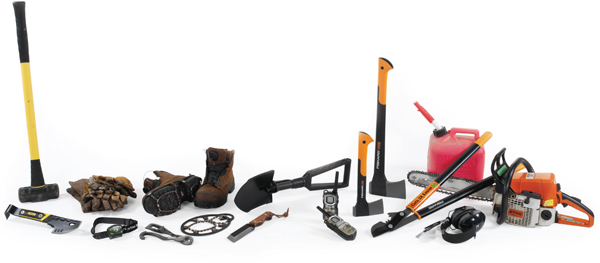

By James Card
A storm just destroyed your community. Wreckage is everywhere and you hear cries for help. Be sure you have the tools you need to get to work.
Concrete makes up a large part of a home, along with lumber. Mixed together in a snarled mass, sometimes brute force is the only way to go until other tools can be used to pry, cut or hack your way in. (Rockforge, homedepot.com)
Use the power of leverage to your advantage when cracking apart nailed beams or lifting some tangled rubble. Keep a large crowbar handy along with smaller ones for tight spaces. The 14-inch FuBar Demolition Bar can hack, pry, pull nails and has a strikeable surface. (stanleytools.com)
After a disaster, it’s all about helping hands. Keep lots of leather work gloves to pass out so people can pitch in without worry of splinters, abrasions, muck and dirt.
There is a good chance you will be working in the dark after a natural disaster and even if there is daylight, you might find yourself peering into a dark hole under a collapsed home looking for survivors. Headlamps are the way to go as they keep your hands free to work efficiently. Princeton Tec’s Vizz has three distinct beam profiles: a powerful spotting beam, a dim flood beam for close-up work and a red beam that protects night vision. (princetontec.com)
A ravaged community recovering after a storm is the opposite of a construction site: it’s deconstruction but the same dangers exist. Body parts can be smashed, hacked or punctured. To keep helping with the rescue effort you have to stay on your feet. The leather 4216 Red Wing Safety boot has a non-metallic toe protector and is waterproof. The BOA lacing system tightens up the boot with a dial for a tight fit and without the worry of laces unraveling or getting snagged and tripping you up. (redwingshoes.com)
For working on slippery surfaces such as an oil spill or on an incline like a sagging roof, use some snow cleats for extra purchase. The Diamond Grip Ice Trekkers were designed for snow and ice but will work in a pinch to save you from slipping and breaking your neck. (icetrekkers.com)
Think of all the hidden wires inside of a building and then the building is turned inside out. You’ll need to cut through tangles of wires of all sizes. The Rescue Tool does that and has a spanner wrench for loosening hose couplings, a pry bar and a slot for shutting off gas safety valves. (channellock.com)
Shovels of all shapes and sizes are useful after a disaster; even snow shovels for scooping out mud and sludge and garden spades can be used to fill sandbags. For tight spaces, like digging near the foundation of a collapsed house, folding camp shovels will get the job done. The Gerber E-Tool is a military-grade digging tool for trenches and holes. It folds up to about the size of a dinner plate and also has a serrated blade edge for sawing roots and a pick for hacking at rock. (gerbergear.com)
For prying apart small stuff, most knives are not up to the task and the blade could easily crack or bend. The Pro Tool Chisel Utility Knife is a combination knife, chisel and pry tool. It can take hammer blows for deeper gouging and it can rip apart a wooden pallet like nothing. The hardwood ash handle gives this beast of a tool a classy appearance. (protoolindustries.net)
With cell phone service disrupted after a disaster, more chaos is added to the equation. Give a two-way radio to your partner and you can scout blocked roads; report the damage and dangers, and round up people for help where it is most needed. The Motorola Talkabout MS355R is a key communication tool for this scenario. It is waterproof, it floats, has a built in flashlight, receives weather alerts and has dual power. It ranges up to 35 miles depending on various conditions. (motorola.com)
With downed trees everywhere, their huge canopies can transform a neighborhood into an instant jungle. A chainsaw will get the job done but if there is a gas shortage, you will want to use it sparingly and save it for the big stuff. Fiskars axes, hatchets and loppers are three key tools for taking down limbs and branches. It’s a lot of muscle work but the tools are lightweight, well balanced and very sharp which make your clearing efforts much more efficient. (fiskars.com)
Other than a dead boat motor, nothing will make a person swear more than a chainsaw that will not start. It’s a lot worse in an emergency situation. Talk to people that cut a lot of firewood and ask professional tree trimmers on what brands they like. The Stihl pictured has been running strong for 15 years (stihlusa.com). For clearing trees after a disaster, an 18-inch bar will serve you well and it is an all-around choice for work around the house or farm. Shooting glasses and earmuffs can serve double duty as eye and ear protection when working with power tools. (radians.com)
Keep an extra gas can full, along with the proper oil mix. Talk with some of your friends and neighbors that will be helping out in the event of a disaster. See what kind of oil/gas mix their chainsaws use so the oil/gas ratio can be mixed and easily shared if gas supplies are low.